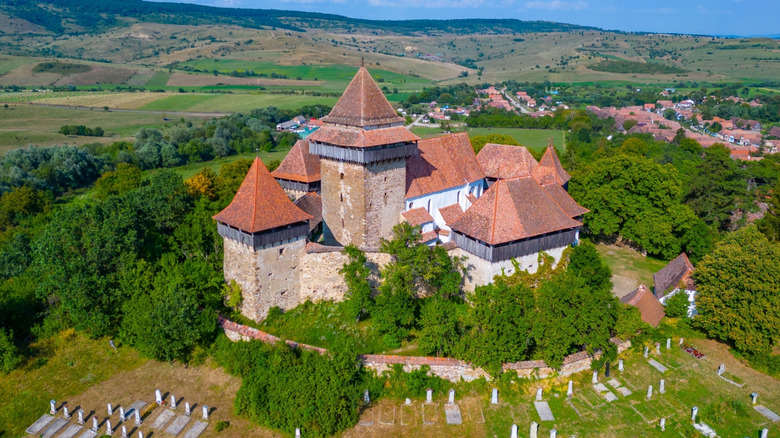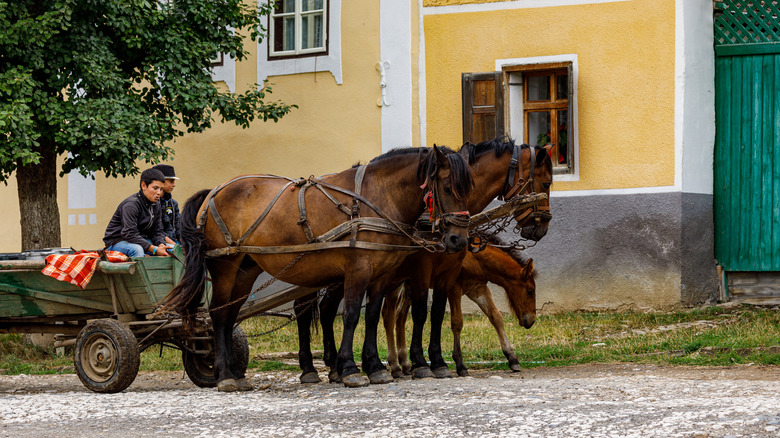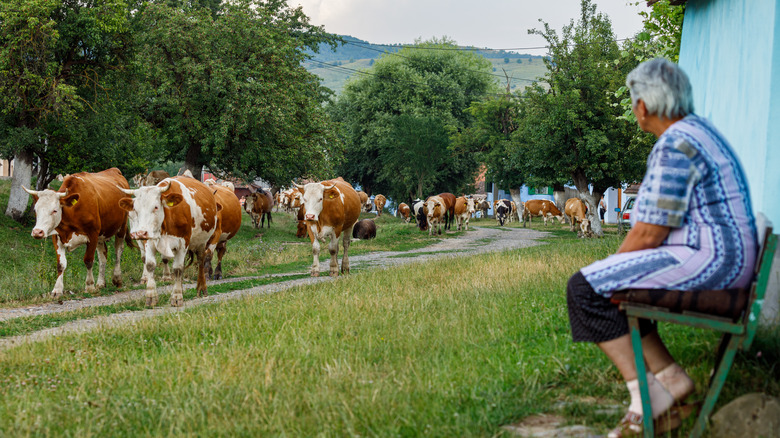This Scenic Romanian Village Favored By Royalty Hides One Of Transylvania's Oldest Fortified Churches
Mention Romania, or more specifically, Transylvania, and one thing will likely spring to mind: Dracula. But while the fictional horror icon's historical inspiration, Vlad the Impaler, does feature heavily in the country's marketing efforts, Romania offers far more than fake-fanged tourist photos. Still a wildly underrated country, Romania's modern capital of Bucharest, Bran Castle, and the Carpathian Mountains steal the headlines, but it's stunning villages like Viscri with its ancient fortified churches and royal connections that keep Romania's history alive.
Located about an hour northwest of the fairytale town of Brașov, Viscri spent most of its almost-thousand years of existence in relative obscurity. The now famous fortified church was built around 1100 AD by the Szchecklers — a Hungarian ethnic group — before being seized by Transylvanian Saxons. It remained a Saxon cultural stronghold for centuries, withstanding numerous attacks, until the Communist regime that gripped Romania fell in 1989. With Romania in pieces, many of its Saxons fled. Now, only a handful remain among its under 500-strong population.
Despite its humble size, the village has become a symbol of sustainable tourism, a UNESCO-protected site, and one of the most-visited villages in Romania. This is owed in no small part to King Charles III of the United Kingdom's love of the village. After visiting multiple times, the king —then prince — purchased an 18th-century house and set up a charity to support traditional craft practices. The exposure has been transformative, allowing Viscri to thrive while cultivating its heritage.
Fortified churches, scenic drives, and traditional culture
The primary tourist draw of Viscri is its fortified church. Impossibly picturesque, the structure has been built, damaged, fortified, and expanded over a thousand years. Its varied architecture, combined with the remoteness of Viscri itself, creates a unique sense of timelessness that has helped stoke the church's popularity. It's only open between April and October, from 10am to 6pm unless there's a church service on, so plan accordingly. Some visitors have suggested the manager of the church may give tours in the off-season, but don't count on this.
The true joy of Visrci comes from simple exploration. The village, despite its growing fame, has worked hard to retain its slow-paced, old-world feel. Clinging to its Saxon heritage, the local buildings, painted in striking colors and framed by the remote Romanian countryside, are as they have been for years. The streets are cobbled, and it's not uncommon to see cows, chickens, and ducks sharing the way with you. You can even visit King Charles' guest house, which is traditionally furnished.
Experiencing the local culture is essential for understanding the value of Viscri. Significant efforts have been made to preserve the way of life there, and it's now possible to watch local blacksmiths, bakers, brickmakers, and other local crafters at work. Opting for an organized tour is the best way to ensure you make the most of your time in the village.
You'll need to work for the experience
While roads are improving around Romania, Viscri remains fairly remote. There are no direct public transport links, so you'll be limited to driving yourself, joining an organized tour, or shelling out on a taxi from a nearby town. It's possible to hail a taxi to Viscri from the town of Rupea — about a twenty-minute drive away — but you'll need to get a train there from Brașov, which can take as long as two hours.
Brașov does have a new airport, but it's still limited in destinations. It's more likely you'll arrive in Bucharest and make your way north from there. Trains connect the capital with Brașov and, less frequently, with Rupea. Renting a car can make the journey a little more adventurous, allowing you to take in the epic Romanian countryside and be less bound to the train times. Just take extra care on the road, as the region is known for its jaw-dropping rate of traffic fatalities.
While the majority of tourists to Viscri are day-trippers, it is possible to stay in the growing number of guest houses. These are generally no-frills experiences designed to immerse visitors in the local culture. Viscri 125 is a notable exception, offering a more modern design within the confines of a traditional home. Rooms start at around $152.


